Birding reports of this Northwest Ohio resident's occasional wild bird sightings from surrounding states, including: 1.Illinois 2. Indiana 3.Maine 4.Michigan 5.Missouri 6.Ontario in that alphabetical order below:
Illinois 4/1/01 In the words of Liz Day, one of 21 of us: Jim and Susan Hengeveld led a very successful trip to Newton IL to see the Greater Prairie Chickens. "On Saturday we saw a small flock of mixed sex feeding at a great distance, and the following morning at dawn we watched about 10 males booming on a lek, and one female apparently window-shopping." Other birds seen nearby: 100's of Golden Plovers, 50+ Pectoral Sandpipers, Pipits. In the town of Newton, about 5 Eurasion collared doves. 7/18/3 Headed out to Burnham Cook County, Illinois to see those
everyone is talking about ( http://chicagowildernessmag.org/issues/winter2003/monkparakeets.html): "For 22 years, feral monk parakeets have lived in the southern part of Chicago, draping their twiggy nests over tree branches, electrical poles, roof rafters, and satellite dishes. This raucous caucus of about 200 birds is the coldest, and perhaps the oldest, colony of monk parakeets in the United States... has survived Chicago's nastiest weather, a significant feat since the bird originates in the temperate, dry lowlands of South America. This is the harshest climate the birds survive anywhere in the world, according to Pruett-Jones. They do exist further north, in Amsterdam and Paris, for example, and during the 1980s they bred in Montreal, but only in the Chicago area do they currently withstand windstorms and ice baths, rain, snow, hail, and temperatures far below zero... Michael Avery, a biologist with the U.S. Department of Agriculture (USDA), asserts that they pose no threat. "There is no documentation of their causing damage to cereal crops in the U.S., and no indication that they are displacing other birds. They are not cavity nesters, like starlings, which displace woodpeckers. Overall, there seems to be no competition for food or nest space...Between 1970 and 1975, a national eradication effort by the U. S. Fish and Wildlife Service and the USDA eliminated them from most Northeastern and Midwestern states. They have since re-established themselves in several areas and continue to thrive in Florida, Texas, Connecticut, and New Jersey, as well as Illinois. States vary in their regulatory approaches — Illinois currently has no restrictions against the birds. When the USDA proposed to eradicate the Hyde Park colony in 1988, outraged residents formed a protest group and a legal defense fund. The agency backed off... Some have suggested that monk parakeets could occupy the niche vacated by the Carolina parakeet, the only parrot indigenous to North America. Extinct from the wild since 1913, the Carolina parakeet had much in common with the monk parakeet. It frequented bottomland hardwood forests in the southeastern United States and lived as far north as Connecticut and at least as far west as Illinois. " A strong storm had just gone through the area so you can imagine driving through south Chicago with the power out (no signals working) but what a sight! VERY MUCH WELL WORTH THE DRIVE! :
It appears to be an ordinary neighborhood...
but even on the highway you can
hear them...
and then you see all these nests! mostly in
locusts...
Sometimes a baby falls out (last
night was a very bad storm here):
This was a fantastic sight and
highly recommended-- WELL WORTH THE DRIVE!!!
Indiana 11/28/99 I found 26+ WHITE-WINGED
CROSSBILLS
among the usual winter residents at Lindenwood Cemetery in
Fort Wayne IN. I failed to see the Red
Crossbills others have seen there. 2 very tame Red-Tailed Hawks kept
these and the Pine Siskins on the run. A large flock of Bluebirds
were also there mixed in with robins and cardinals! I checked
Defiance's Riverside Cemetery and Sherwood Cemetery upon my return,
but no crossbills here. 4/2/2000 Just west of Harlan,IN on SR37, 3 Sandhill Cranes flew over. 5/13/2000 Franke Park in Fort Wayne
IN, a
two-hour walk resulted in only a Magnolia Warbler, an Ovenbird, 2
Veeries,about 20 Swainson's Thrushes, Indigo Buntings, and of course
Mallards and Domestic Duck/Goose crosses. Cinquefoil, Golden Ragwort,
Dame's Rocket, Fleabane there, too. I noticed lots of Hepatica, but
strangely not in bloom yet.5/20/2000 A trip to Fort
Wayne's
Fox
Island and the
first bird I hear/see is BELL'S VIREO, as advised on
the Indiana-Bird listserve via Brad Etter, Jim Haw et al. Of course,
it had to be all downhill from there, but there were Indigo Buntings,
Red-Eyed & Warbling Vireos, Pewees,Spotted Sandpipers, Thrashers,
Green Herons, etc to name a few. The damp forest was still dark at
noon, and it was eerie to hear the thrushes, especially the querulous
veeries and the wood thrushes. My first visit there and only had time
to walk half. Wild Columbine and Bramble were still in bloom
everywhere, as was Jack-In-the-Pulpit. 6/3/00 LigonierIN at the McDonald's was a Mulberry Tree that
could've better been called a Cedar Waxwing Tree as many as were in
it! 9/16/00 Franke Park in Fort
Wayne was
just a drive-thru since we were really just doing the mall thing.
Hundreds of Canada Geese were being chased by two small 3-year-olds
with no parental unit in sight! Many visitors were feeding hundreds
of Mallards and Mallard mixes, with many Ring-Billed Gulls at the
perimeter anxious for scraps. I fed a hundred more Ring-Bills at all
the malls (Glenbrook, Northwood, Maplewood, Maplecrest, Georgetown
etc) looking for the reported Laughing Gull (J Willet says it was
only the second one ever for the area), but came up empty-handed.
9/2/2000
Quick trip from
this end of Indiana to that end found Mississippi Kites at Dale,
Indiana's
Lincoln State Park. Fantastic viewing. First
bird sighted was a GOSHAWK, unbelievably
enough-- a local birder advised me that some nearby falconers often
have escapes. 11/20/2000 This may have been the silliest birding
excursion in which I have ever participated: right after work I
decided to head to Crooked Lake, Angola
IN
to hopefully
get the reported Red-Necked Loon for my list. Visibility was high and
light good, but I knew I must not delay as it gets dark by 5:15 and I
get off work at 3:30. The closer I got to Angola, though, the more it
snowed! Visibility at Crooked Lake was very poor once I did arrive,
and all I could see was a surreal sight: hundreds of coots, as far as
the eye can see (which is none too far), bobbing up and down on an
ocean of black in the middle of a swirling snowstorm. Even more
remarkably, as I neared home once again, the skies cleared, and there
was no snow at all at home, less than an hour away! Pioneer Ohio,
only 25 miles away, received 5 inches of snow while we had none!
1/28/01
My very first
trip to Fort Wayne
Sewage
Lagoons. I
didn't even realize they were there in this very busy part of the
city: lots of Mallards, Canada Geese, Common Mergansers, and Common
Goldeneye. a few Black Ducks, Gadwall, Northern Shoveler, Coots. One
Hooded Merganser, one GreenWinged Teal, one PiedBilled Grebe. Enroute
home I stopped off at the deadend of Fort Wayne IN's Hardisty
Rd to see the
male VARIED
THRUSH, thanks
to the kindness of the Davises. 2/19/01 Fort Wayne
IN
Sewage Lagoons were a huge surprise with 9 SANDHILL
CRANES amidst
the 250 Canada Geese, 175 Mallards, 52 Crows, 35 Coots, 25 Black
Ducks, 20 Starlings, 20 Common Mergansers, 10 Gadwall, 5 RingNecked
Duck, 5 Northern Shoveler, 3 Wigeon, 2 Greater-, 2 Lesser Scaup, 2
Pintail, 1 Belted Kingfisher, 1 PiedBilled Grebe, 1 Great Blue Heron,
1 GreenWinged Teal, 1 RedTailed Hawk, 1 Song Sparrow (numbers
approximate of course, except for the Cranes). 4/8/01Rushed to Franke Park in Fort Wayne
IN although
seriously lacking in sleep to see the reported franklin's gull. I did
see large groups of Brown Creepers and Golden-Crowned Kinglets and a
Mourning Cloak at the park. No luck with the gull, but did meet up
with Jim Haw and Dave Reichlinger, who graciously invited me on a
field trip with the Stockbridge Audubon Society to Hurshtown
Reservoir and Woodburn Sewage Lagoons. A wonderfully friendly group,
we saw my first CASPIAN TERNS (5), COMMON LOONS (4 in summer plumage,
2 in winter), OSPREY, Brown Thrasher, Barn Swallow, Purple Martin,
DoubleCrested Cormorant of the season, as well as Gadwalls,
Mallards, Coots, Lesser Scaup, Ruddy Ducks, RingBilled Gulls,
Cooper's Hawk, Turkey Vultures, Tree Swallows, Bufflehead, BlueWinged
Teal etc.
4/16/01 Returning from Kansas City, no real great
birds. Almost home, at Lake St James
near Angola IN, was a Mute Swan. Spring seemed almost a
month ahead of DefianceCo OH in Kansas City! 4/21/01 Drove the 175+ miles to
MontgomeryCounty IN, on the Illinois border, seeing
13Lined Ground
Squirrels avoid
a Coyote, Savannah and Vesper Sparrows, Cowbirds, Starlings, House
Finches, Meadowlarks, Horned Larks, Rabbits, Killdeer among other
things emerge from what anyone driving by would assume to be a
lifeless cornfield, with only the cut-off stalks left. Finally, after
4 hours of searching, there emerged: SMITH'S LONGSPURThe ODNR says I shouldn't have had to
drive so far: "From the 1940’s until the early 1970’s, this species
was recorded with regularity in western Ohio. However, in recent
decades it has become inexplicable absent, with the last record from
Cuyahoga County in 1991. They should be sought in March and April in
the western half of Ohio. Good habitats might be the short grass
areas around airfields, and winter wheat fields." 4/28/01 Once again, I accompanied
Stockbridge Audubon Society of Fort Wayne IN on one of their field trips,
this time to Salamonie Reservoir, a little south of Fort Wayne. Had a great
time with these incredibly friendly folk and saw over 100 species of
birds. Those that were first-of-the-season for me included:
LITTLE BLUE
HERON (bird
#100), Green Heron, BROADWINGED HAWK, SORA (at least 20 of
them!),
Solitary
Sandpiper, Great Crested Flycatcher, Eastern Kingbird, WhiteEyed
Vireo, Warbling Vireo, YellowThroated Vireo, Carolina Chickadee,
Carolina Wren, RoseBreasted Grosbeak, Baltimore Oriole, Orchard
Oriole, YELLOWBREASTED CHAT, Common Yellowthroat, Louisiana
Waterthrush, Northern Parula, BlueWinged,
YellowThroated,
PRAIRIE, and
Nashville Warblers. Guess it pays to have over 20 pairs of
eyes and ears. Also remarkable was stunning viewing of a Great Horned
Owl, stunning viewing of American Pipits, a Common Loon still around,
at least 20 Common Snipe, a late Hooded Merganser drake, but best of
all:CERULEAN WARBLER LeCONTE'S Sparrow6/14/2001 Thanks to the internet IN-BIRD tip from Ed
Powers, on a trip to Fort Wayne IN, 15 minutes from Glenbrook Mall, were
three fantastical LOGGERHEAD SHRIKES!!!! 7/7/01 I didn't go to Wolf Lake,
Indiana to bird, but there was an exceptionally
friendly PiedBilled Grebe there:
9/6/2001 Took the day off work to unsuccessfully
try for the swallowtailed kite at Indianapolis. 9/8/2001 Joined Stockbridge Audubon Society at
Fort
Wayne's
Fox Island,
where we saw
CAROLINA CHICKADEES, BROWN CREEPERS, BlueGray Gnatcatchers, VEERIES,
Swainson's Thrush, Wood Thrush,
TENNESEE/NASHVILLE/CHESTNUTSIDED/BAYBREASTED/BLACKTHROATED BLUE &
GREEN/BLACK&WHITE/WILSON'S WARBLERS, OVENBIRD, AMERICAN REDSTART,
Common Yellowthroat, SCARLET TANAGER, Eastern Towhee, many
RoseBreasted Grosbeaks, Of course, there were also the normal birds
(Turkey Vulture, Mallards, Cooper's Hawk, Pectoral Sandpipers,
RIngBilled Gulls, Mourning Doves, Chimney Swift, Hummingbirds,
RedBellied/Downy/Hairy Woodpeckers, GreatCrested Flycatcher,
YellowThroated/Warbling/RedEyed Vireos, BlueJays, Crows, Purple
Martins, WhiteBreasted Nuthatch, Tufted Titmice, Starlings, Gray
Catbirds, Cedar Waxwings, Song Sparrow, Cardinal, Indigo Bunting,
RedWinged Blackbirds, Common Grackles, Goldfinches and many many
Peewees).
9/22/2001 I
elected to join Stockbridge Audubon Society at Salmonie Reservoir,
IN. Leader Jim
Haw e-mails his report: "The Stockbridge Audubon Society field trip
to Salamonie on Saturday had ten participants and (it
seemed) fewer than ten birds. Despite the fact that Rodger Rang and I
both heard numbers of thrushes migrating overhead in Ft. Wayne before
dawn, birds of all types were as scarce as I can ever remember in
September at Salamonie. We recorded 60 species; highlights: Osprey 1
Broad-winged Hawk 1 Yellow-billed cuckoo 2 E. Wood Pewee 2 Vireos:
White-eyed 1, Yellow-throated 1, Red-eyed 4 GOLDEN-CROWNED KINGLET 1
(early) Swainson's Thrush 3, Warblers: Tennessee 1, Magnolia 1,
Yellow-rumped 1, Black-throated Green 2, Palm 1, Blackpoll 1, Common
Yellowthroat 4, HOODED 2 (late), Rose-breasted Grosbeak 1,Purple
Finch 4." My first of the season birds were GOLDEN CROWNED KINGLET,
PALM & HOODED WARBLER (seen from beak to tail-tip in a non-leafy
area, a wonderful male!), and PURPLE FINCHES. The Yellow-Billed
Cuckoo, YELLOW-THROATED VIREO, and a calling juvenal Horned Owl were
clearly seen and at great length, which made their appearance all the
greater. The HOODED WARBLER was definitely the bird of the day, but I
was not disappointed at all even though surrounding areas gave
glowing reports of warblers dripping from the trees... Also seen were
PiedBilled Grebes (6?), Phoebes (2?), Shaprshinned and Cooper's and
Red Tailed Hawks among the more common birds. 10/6/2001 Joined Fort
Wayne's
Stockbridge Audubon Society at Franke Park this morning (and what a fine morning, the
opposite of what the weatherman predicted-- not windy, not cloudy,
not raining). Leader Rodger Rang emailed this report: "Eleven birders
participated in Stockbridge Audubon Society's bird hike at Franke
Park this morning. On this very delightful fall morning, we tallied 8
species of warblers but very few sparrows other than white-throats.
Among our 48 species, we had: Pied-billed Grebe 2, Double-crested
Cormorant 6, Wood Duck 5, Ring-necked Duck 7, Ruddy Duck 1, Cooper's
Hawk 4 (all in one group, one giving a crow in flight a good scare),
American Coot 1, Chimney Swift 4, Belted Kingfisher 1, Empidonax sp.
1, Eastern Phoebe 2, Red-eyed Vireo 1, Golden-crowned Kinglet 10,
Ruby-crowned Kinglet 4, Eastern Bluebird 1, Hermit Thrush 4, Gray
Catbird 3, Warblers- Nashville 1, Chestnut-sided 1, Magnolia 1,
Yellow-rumped dozens, Black-throated Green 3, Palm 4, Blackpoll 1,
American Redstart 1, Chipping Sparrow 10, White-throated Sparrow
dozens, Dark-eyed Junco 10." I personally missed the Grebes and the
Black-Throated Greens, but can personally add a Solitary, er,
BlueHeaded Vireo, the first I have seen for a very very long time.
And it was so sad seeing the Juncos so early, the first I've seen
this year. Winter's coming...10/13/2001 Today joined the Fort Wayne Stockbridge
Audubon Field Trip along the Lake Michigan lakefront between Michigan City and
Chicago. I
thoroughly enjoyed birding with a group as opposed to birding alone,
although there are of course distinct advantages to each. One great
advantage to group birding was the fact that I didn't have to drive!
Another? Gas was much cheaper than if I'd driven myself. The
comaraderie was wonderful. And lots of eyes are better than just two.
Plus I can just suck up all this experience and knowledge around me.
For instance, I usually ignore juvenile gulls as something a bit
beyond my ken. I was amazed today therefore at how easy it was to
pick out the first-year winter GREAT BLACK-BACKED GULL. Alone I
would've spent hours examining juvenile gulls and then consulting my
guides. I may have never spotted the PEREGRINE FALCON on the far
breakwall-- I certainly wouldn't have expected one on a beach.
Although the PARTIAL ALBINO HERRING GULL's whiteness stood out like a
sore thumb once it had been pointed out to me, would I have noticed
it on my own? Probably not. Forsythe Park was made up mostly of about
10-20 Mute Swans, maybe 100 Coots, and YellowRumped Warblers. We
never even got out of the car, due to the advanced scouting of Jeff
McCoy et al, another advantage of group birding. At the Migrant Trap
(situated similarly to Crane Creek's Boardwalk but on a different
lake), I would have been totally embarrasseed to report the amazing
number of ORANGE-CROWNED WARBLERS. I have never ever seen more than
one at a time, and usually only one a year! To see them everywhere
was totally flooring, and the fact that other experienced birders
could validate this sighting is yet another reason group birding is
so great. Who would have thought we would see so many warblers so
late?!! Although I missed the mourning warbler Susan found (a
disadvantage of group birding-- now you know what you missed!), and
all those lifers I was hoping to see (jaegers, Nelson's sharp-tailed
sparrow, scoters), it was a great time for this extremely amateur
birder. That is probably why I feel so bad about teasing our group
leaders, Jeff McCoy and Ed Powers, for deciding to leave in the
pouring rain before seeing the Nelson's. I hope they didn't take me
seriously in the slightest, cuz it was a great trip in my mind. Ken
Brock and his Northwest Indiana group were also there, making for a
group of 15 or 20 or so. I'm not sure how he came up with numbers
<grin>, but here is his edited email report: "We were hoping to
beat the rain, which was forecast to begin in afternoon. Alas, the
meteorologist missed it again- the rain started at 9:30AM.
Fortunately the rain was light throughout the morning allowing us to
bird Forsythe Park and the Migrant Trap. Highlights Osprey (1 at
Whiting Park) GREAT BLACK-BACKED GULL(1 first-year at MCH) MIGRANT
TRAP (As we reached the trap there was a steady stream of
Yellow-rumped Warblers flying eastward over the Trap. Inside we
counted 13 warbler species, which is an unprecedented number for
mid-Oct.). The trap was a cauldron of bird activity. Double-crested
Cormorant (250- perched on offshore water intake) Yellow-bellied
Sapsucker (6) N. Flicker (2) E. Wood-Pewee (1- second latest Dunes
area record and latest in 50 years) E. Phoebe (1) Empidonax species
(1- a very interesting bird that showed characters ofHammond¹s
Flycatcher) Red-breasted Nuthatch (2), Brown Creeper (4), Winter Wren
(4), House Wren (2), Golden-crowned Kinglet (10), Ruby-crowned
Kinglet (6), Hermit Thrush (10), Cedar Waxwing (12), Tennessee
Warbler (3- eighth latest Dunes area record)),ORANGE-CROWNED WARBLER
(7- ties the Dunes area record set at Cowles Bog 16 Oct 1983- Thanks
Ed) Nashville Warbler (3), Magnolia (1- eighth latest Dunes area
record), Yellow-rumped (145, which includes birds flying over the
Trap), Black-throated Green Warbler (3), PINE WARBLER (2 ad. males-
highest fall tally ever for Trap), Palm Warbler (20), Blackpoll (1-
fifth latest Dunes area record), American Redstart (1- seventh latest
Dunes area record), Ovenbird (1), MOURNING WARBLER (1- im. male or
ad. female- ties late date for Dunes area-way to go Susan), Chipping
Sparrow (3), Song Sparrow (8), Lincoln¹s Sparrow (4), Fox
Sparrow (1), Swamp Sparrow (15), White-throated Sparrow (30),
White-crowned Sparrow (10), Dark-eyed Junco (8), Indigo Bunting
(3)--Ken Brock Chesterton, IN" 11/10/2001 Another 60-degree sunny November day, an
excellent day to Join Fort Wayne's Stockbridge Audubon Society at
Indiana's Lake Michigan. Most of the 30+ birders there seemed to be
disappointed by today's birding, but what could be better than the
Sears Tower in the mist of the distant shore, behind quite a
fewRED-THROATED LOONS.
Other good birds
today were BLACK
SCOTER, RUSTY BLACKBIRD (a bird I have an inexplicable affinity
for), NORTHERN
SHRIKE (a bird
I have an inexplicable dislike for), and my FIRST ROUGH-LEGGED HAWK of the season. Not bad were Horned Grebe, Snow Bunting,
a lone Sanderling, a drake Wood Duck, Black Duck, Common Loon,
Redhead, Greater & Lesser Scaup, RedBreasted Merganser, Cooper's
& SharpShinned Hawks, Bonaparte's Gulls etc and of course there's
the inevitable list of Canada Geese, Great Blue Heron, Mallard,
RedTailed Hawk, Kestrel, Coot, RingBilled & Herring Gulls etc. I
personally missed the Great BlackBacked Gull (a no-harm-done miss)
and whitewinged scoter (a very very very bad miss for me). Mildly
interesting were two Rock Doves amidst the gulls on the shoreline--
many times I have seen the two together in farmer's fields here in
northwest Ohio, but never on a beach! Ken Brock writes on IN-BIRD,
the Indiana Listserve: "A plethora of birders covered the Indiana
lakefront today (10 Nov 01). My group consisted of John Cassady,
Clyde Fields, Lynea Hinchman, Perry Miller, and Dan Stoltzfus. For
part of the day we joined forces with Jeff McCoy as he led a large
group from the Stockbridge Audubon Society. Steve Doud also brought
along a small group. Others encountered at various locations included
Don Gorney, Brendan Grube, Ed Hopkins, and Michael Topp. The birding
quality was below expectations for 10 November. In early morning the
40 degree southwest wind at 15 knots, made birding at Michigan City
Harbor difficult. A front was forecast to pass during the day with
brisk northwest following winds. The front apparently arrived too
late for our birding day. As a result, after the morning surge, there
was very little movement on the lake. Locations: Michigan City Harbor
(MC), Beverly Shores (BS), West Beach (WB), Miller Beach (MB).
HIGHLIGHTS-RED-THROATED LOON (7- 1 BS, 3 WB, & 3 MB) Common Loon
(262- logged by Gorney & Topp during a morning lake watch at MB),
Horned Grebe (58 for the lakefront), Redhead (40 MC, 4 MB), Greater
Scaup (100 MC) Scaup species (465- Gorney & Topp during morning
lake watch at MB) WHITE-WINGED SCOTER (1- Gorney & Topp at MB )
BLACK SCOTER (4 MC, 4 MB) Dark-winged scoter (10 MC) Bonaparte's Gull
(10 lakefront) GREAT BLACK-BACKED GULL (1 ad BS) Cooper¹s Hawk
(1 im. WB) Sharp-shinned Hawk (1 im WB) NORTHERN SHRIKE (1 BS- seen
by McCoy, Stockbridge & et al.)--Ken BrockChesterton,
IN 4/7/02
Another nice
thing about birding with a group is someone else does the counting
for you! Jim Haw, with the Stockbridge Audubon Society, estimates
from Fort Wayne's Hurshtown Reservoir (my firsts for the year in
bold):
Common Loon 2,
Pied-billed Grebe 2, Horned Grebe 20, Double-crested Cormorant 24, Canada Goose, Gadwall 6,
Am. Wigeon 2, Mallard 2, N. Shoveler 3, Canvasback 1, Redhead 20,
Ring-necked Duck 60, Lesser Scaup 100+, Bufflehead 15, Red-breasted Merganser 50, Common
Merganseer 2, Osprey 1, Am. Coot 300, Bonaparte's Gull 4,
Ring-billed Gull 10, Tree Swallow 20, Barn Swallow 2. Joe Hildreth and I were two of quite a
large number of participants. We had gone originally to look for the
piping plover reported at Huntington Reservoir, which unfortunately we were
unable to locate. There was my first Phoebe of the season. John Winebrenner and Sandy
Schahdt told me they both did get to see this bird last night,
however, about 7:15pm before it flew off. heading to FortWayne's Franke Park
after noting a
report of a golden-winged warbler. No such luck, and I was really
disgusted for awhile until I relaxed to enjoy the spring weather, and
the birds that were there: my first Black-and-White, Nashville, Black-Throated
Green Warblers, BroadWinged Hawkand Northern
Waterthrush of
the season. Two separate incidents of Ovenbirds being so amazingly
close. Lots of Baltimore Orioles. As I started to leave I decided to
check the pond, only to find among the usual Mallards and domestics,
a female Ruddy Duck and yet another WILLET. A pair of Cooper's Hawks flew over,
spooking the Willet causing it to flash it's great gaudy wings as it
boomeranged over the pond and returned. Classically beautiful. A note
on the hotline says that all three species (Cooper's, BroadWinged and
RedTailed) are nesting in this tiny park near both downtown and the
busy Coliseum Blvd Mall area of Fort Wayne. Doug's report on
OhioBirds@Envirolink: "...a real, live Willet, only our second
Paulding County record (The first was in May of 1989)!!!" Below are
stills hurriedly taken from 8mm video, at Franke Park:
5/10/02 Shopping in Fort Wayne only to see a male ORANGE-CROWNED WARBLER hopping ahead of me on the sidewalk at Glenbrook Mall! 5/27/02 Decided at the last minute to join Jeff McCoy's group at Kankakee Sands in NewtonCounty IN. An hour into the trip the car turned over its first 100,000 miles, and I haven't paid the 23rd payment yet! Oh well. Yahoo's recommended directions were to take 6 hours and 2 minutes, but I made it in four hours, so at 4am a dozen of us grouped around a recorder playing an endless tape. This was to be a hearing only tour, with pumping Bittern, Ring Necked Pheasants, lots of Grasshopper Sparrows, and best of all, what sounded like 6 or 8 feet away,BLACK RAILA ruff and a white-faced ibis were nearby but I rushed home for the family Memorial Day picnic. Taking a different route home saved an hour and 100 miles. I had driven all night there and back with no sleep but was not tired at all, flushed by the encounter with the rail. 6/8/02 When I got home I read the message on Ohio-Birds@Envirolink from Phil Kelly: "Jeff McCoy just called from the field to report that the Saturday morning Brock group" had found a FULVOUS WHISTLING-DUCK at the Grand Kankakee Marsh in Southern Lake County, in northwest Indiana. The bird was found at 9:15 AM CDT / EST. See Delorme Atlas pages 19 & 25. To reach the bird, in southern Lake County, take I65 to Indiana 2. Go east for 2 miles to Union Street, turn South, and proceed untill the road T's (about 3 miles--last portion being gravel). Turn left at the T and go until the road is gated. Park there, and continue walking down the road. The bird was on the impoundment on the left side of the road, about 100 yards from the gate." So Bruce and I headed out immediately. I arrived on the heels of Brad Jackson. Already there were Peter Grube and Steve Pancol. Andy Siegler arrived shortly after. Don Gorney had been there earlier and listed these other birds as present as well on IN-BIRD-L@indiana.edu: "Pied-billed Grebe - 5, some calling and two seen on nests, Great Egret - 1, Wood Duck - 1, Gadwall - 2, Blue-winged Teal - 3, all males, Northern Shoveler - 1, Northern Pintail - 4, Redhead - 1, Ruddy Duck - 17, WOW, nice sight for June in Indiana, Black Tern - 1" Ken Brock, one of the initial discoverers, wrote on IN-BIRD-L@indiana.edu: "Today (8June 02) Susan Bagby John Cassady, Lynea Hinchman, Jeff McCoy, Dick Plank, and I birded sites in Newton, Lake, and LaPorte Counties. We had a superb day with the discovery of an adult FULVOUS WHISTLING-DUCK at Grand Kankakee Marsh in s.e. Lake County....We watched the bird for 1.5 hours, digital photos were obtained. The bird was quite skittish, flying on several occasions and remaining very alert. It was not banded and showed no signs of cage wear on the plumage...This is the fifth Indiana record... Gadwall (2), N. Shoveler (1), N. Pintail(1-drake), GreenWinged Teal (2-drakes), Redhead(1), Hooded Merganser (4), Ruddy Duck (18), Semiplamated Sandpiper (2), White-rumped Sandpiper (1)." Phil Kelly arrived just as we were leaving, anod wrote on IN-BIRD-L@INDIANA.EDU: My wife, sister, brother-in-law, mother and father all made the trek up to try and see the Fulvous Whistling-Duck reported earlier in the day. I successfully convinced my non-birding family to alter our afternoon plans to see if they might actually like birding. This was their first time and they appeared to enjoy it (well, at least they humored Jo and me! :-). When we arrived (about 5:00 p.m.?), we met Andy Seigler (Illinois birder) just leaving. He had just seen the bird. We also saw an unnamed Ohio birder who was also successful." I, of course, was the unnamed Ohio birder, and saw the above birds (more Pintails, missed the sandpipers and greenwinged teal), but didn't count any of them since I was most enthralled by the Fulvous Whistling-Duck8/11/2 I arrived home to find the great Jim Haw of Fort Wayne Stockbridge Audubon Society had left the following e-mail: "I found an adult Piping Plover this morning at a large pond on Engle Road between West Jefferson St. and Smith Road on the southwest side of Fort Wayne. From I-69, take exit 102, U.S. 24 west, but turn northeast into Ft. Wayne. Go to the second stoplight and turn right (east) on Engle Road. The pond is roughly one mile down on the right. There is a grassy dike perpendicular to the road extending well into the pond, and a mudflat on one side of this dike. The plover was at the back end of this mudflat, sometimes briefly getting out of sight behind a line of tall weeds. One feature appears not to fit the ID at first glance--the bill looks black. But, with a high-powered scope, one can see that the basal portion of the upper mandible is orange. I assume the rest of the bill is just covered with mud. This is the second northeast Indiana record of Piping Plover since we began keeping records in 1969, the other coming earlier this year." Surely enough, Mom and I pulled up at Fort Wayne's Engle Road and easily found the amazing rarity:
Don Gorney of Indianapolis was one of the birders assembled there, and made the following report of our time there: "The Piping Plover was present from 1:00pm until 2:30pm when I left the site. The adult bird is unbanded. It spent most of the time on the far right side of the impoundment where there are exposed mudflats. At one point it took flight, circled around some, and landed with the gulls on additional mudflats towards the center of the impoundment. The uppersurface was incredibly pale with only hints of black in the outer wings that I could see. I, along with others, scoped from the road but you do have to contend with a lot of fast-moving traffic. Or, you can go through some weeds and scope from the edge of the impoundment. A scope is extremely helpful. A nice bird that I have chased several times only to come up empty. I gave the lakefront one chance this year and had no plans on going back so I am grateful for the find."10/8/2, 10/9/2, 10/10/2 Tried every night for the nelson's sharptailed sparrow reported at Salamonie Reservoir near HuntingtonIN but am failing miserably. Many nice birds are there, however, namely lots of both Kinglets, Warblers (mostly YellowRumped but also Nashville, Tennessee, BayBreasted etc), WhiteEyed Vireo, WhiteCrowned & White Throated Sparrows, etc. The whole time there last night, a Wilson's Warbler followed me! 11/17/2 The day free to perhaps go see the painted redstart up by Mackinac in Michigan (pretty far away, but has been there awhile, only fleeting glance likely since it's not at a feeder), or perhaps the parastitic jaegers at Cleveland (only distant, very distant looks are likely), or perhaps (since the drive is shortest by far, Jasper Pulaski Indiana at only 135 miles away, fairly close views are possible, even in the main bird's absence there would be plenty to see with the SANDHILL CRANE spectacle and lots of great birders to chat with, and this bird if it had appeared would have been phenomenal) the whooping crane. Barney Dunning writes of 11/16 on INBIRD: " ...We then went on to J-P and arrived about 5 PM to discover the Whooping Crane right in front of the observation post. Much whooping again from the field trip participants (unanswered by the crane). The crane did move rapidly around within the crane field, as mentioned by a previous post today. In our view, however, it was due to the aggressive attacks by many of the Sandhills. The Whooper stayed around for about 20 minutes then flew to the north. I got to talk briefly with the FWS intern who is following the crane from Wisconsin (she is in a truck, not an ultralight). The Whooping Crane was extremely easy to spot amid the estimated 20,000 sandhills. [There were many more Sandhills than last week, when the official count was 15-16,000.] Even when it was furthest from us, the bright white plumage stood out. And everytime someone pecked it, the crane opened its wings, showing the black wingtips. Quite a thrill..." To say the least. This Whooping Crane, we were warned, is not ABA countable, but so what! I don't know what bird in the future could possibly top this one-- from childhood this bird has been as legendary as the phoenix, rising alive from the flames much like the phoenix itself. With less than 400 left in the world, I am totally blown away by this appearance at Jasper-Pulaski. (for more info consult http://www.BringBackTheCranes.org/crane-info/index.htm, a wealth of information on Whooping Cranes. Although the Whooper wasn't there, there were RedShouldered, RoughLegged, Cooper's and SharpShinned along with the usual RedTailed Hawks and Kestrels. Turns out, none of the birds (painted redstart, parasitic jaeger, whooping crane) reported the day before were to be seen today! Oh well, it was fun.6/5/38890 Harrison Parkway, Fishers IN, very near Indianapolis Darel Heitkamp was our most gracious host today, so much so that when I pulled up to this very residential area he had his scope already trained on the bird and I needed to only walk up and view!!!! Incredible. When I arrived home and read my e-mail I found out I was also the first out-of-state birder to view the bird. Darel on INBIRD: "...All 22 birders who have come for the bird thus far have seen it. Our first out-of-state birder (Ohio) came today..." What caused all this excitement?White-Winged Dove And why is this exciting? This bird lives only in the very southern parts of Calivornia, Arizona, New Mexico and West Texas! Ohio has only one record of this bird: Logan County the second week of June 2000. This is Indiana's second photo-documented record. And it was so easy. Reports are that this is a female bird, judging from its position during copulation with the local Mourning Doves! 7/18/3 Then I drove to the other end of the state, Gibson Lake Gibson County Indiana where I had also long read about the easternmost colony of the interiorLEAST TERNSFrankly, the view was terrible. In one direction they were silhouetted by the sun and in the other they were so far away scope distortion marred the view. WORD: DO NOT BOTHER GOING HERE WITHOUT A BIRDING PERMIT (I had tried but the man in charge was on vacation as was his substitute, and the third in line didn't know what to do, so I just decided to risk it. Bad choice.). Not worth the drive this trip at all, and only by the grace of God Almighty did I happen upon the nearly worthless view that I got. The historicity of this amazing group was the only redeeming quality of this for me (http://endangered.fws.gov/esb/2000/07-08/10-11.pdf http://library.fws.gov/Birdscapes/fall00/Partner.html http://www.cinergy.com/News/corporate_news.asp?news_id=91 https://ars.fws.gov/regmap.cfm?arskey=7249 ): " Cinergy Corporation is the parent company of PSI Energy, Inc., Indiana’s largest electric supplier serving 655,000 customers in 69 of the state’s 92 counties. However, the company produces more than electricity. Cinergy’s Gibson Generating Station in Gibson County, Ind., also produces federally-endangered interior least terns (Sterna antillarum). In 1986 a single pair of least terns was discovered nesting on the dike at Gibson Lake, a shallow impoundment constructed as the source of cooling water for the plant. When the terns were discovered, Cinergy immediately began a cooperative program with the Indiana Department of Natural Resources to protect the nesting birds, and later to conserve and enhance their habitat. Cinergy’s efforts were successful in attracting nesting terns to return to Gibson Lake in subsequent years and, while the level of nesting activity varies annually, the population has increased. This is most easterly known colony of interior least tern and the only colony in the state of Indiana... [...one of only two known colonies east of the Mississippi River"] This year there was a maximum of 110 adult terns present, at least 50 eggs hatched, and approximately 27 chicks fledged ["...The largest population...was in 1998, when 85 adults produced 72 fledglings..."] . Aggressive measures were used to minimize predation including the use of quail eggs treated with taste aversion chemicals to deter avian predators. ..." It was refreshing to see Bobwhites crossing the road often, a sight I haven't seen back here in Northwest Ohio since I was a boy. Tons of Dickcissels, Indigo Buntings, and even Chats. One YellowBilled Cuckoo, but of course, my whole visit was focused on the terns and these birds were seen only because they demanded to be seen <grin>.9/13/3 Steuben County IN Pokagon State Park Joined Fort Wayne's Stockbridge Audubon Society for a walk through the trails-- started with about 25, but down to 7 of us by lunchtime. Highlights included: Warblers (Tennessee 1,Chestnut-sided 2, Magnolia 5, Black and White 1, Am. Redstart 4, Com. Yellowthroat 1, Hooded 1, Wilson's 2, Canada 1), Vireos ( White-eyed 1, Yellow-throated 5, Warbling 1, Red-eyed 8), Pied-billed Grebe 1, Green Heron 3, Broad-winged Hawk 1, Ruby-thr. Hummingbird 3, Pileated Woodpecker 2, E. Wood Pewee (many), Acadian Flycatcher 1, Carolina Wren, Blue-gray Gnatcatcher 1, Swainson's Thrush 8, Wood Thrush 2, Cedar Waxwing (many), E. Towhee 1, Field Sparrow, and Swamp Sparrow. 10/11/3 Monroe County IN Lake Lemon I missed both the Stockbridge and Black Swamp Audubon Field Trips to try unsuccessfully for the sabine's gull. From Hengevelds on IN-BIRD: "In several hours of looking this morning throughout Lk. Lemon, Susan & I, Don Whitehead and John Lawrence, and a couple of other groups have not been able to find the Sabine's Gull. As we have seen, this does not necessarily mean that it has left the area," and Don Whitehead on IN-BIRD: "...Ran into Jim Hengeveld who was also searching for the Sabine's Gull and Michael Brown and a colleague. Little Africa: Pied-billed Grebe 5, Double-cr. Cormorant 14, Am. Coot 45, Sora 1 (calling from lotus), Great Blue Heron 7, Ring-billed Gull 16, Killdeer 25, Wilson's Snipe 3, Mallard 7, Green-winged Teal 16, Blue-winged Teal 2, Wood Duck 9, No. Flicker 2, Am. Redstart 1, Yellow-rumped Warbler 14, Field Sparrow 2, Song Sparrow1, White-thr. Sparrow 3, Fox Sparrow 1, Red-winged Blackbird 30, Rusty Blackbird 9 (my first this Fall), Co. Grackle 8, Riddle Point and IU Sailing Club: White Pelican - 1 (on dock of IU Sailing Club), Double-cr. Cormorant 12, Ring-billed Gull 20, Yellow-rumped Warbler 30 (many feeding on poison ivy berries), Chipping Sparrow, Rose-br. Grosbeak, No sign of the Sabine's Gull despite careful searching." Aaron and I also add a Tennessee Warbler, a Cape May, RedHeaded Woodpeckers, a Scarlet Tanager, Cooper's Hawk, a small kettle of Turkey Vultures and an adult BALD EAGLE that entertained us at the Point while we held vigil. 3/21/4 Allen County, Indiana I joined the Fort Wayne Stockbridge Audubon Society's 2.8 mile drive around Hurshtown Reservoir on a very windy and snowy led by Tony Acosta, 12 cars in all. One of the participants, Jeff McCoy, posted the results on IN-BIRDS: Common Loon 1, Pied-billed Grebe 1, Horned Grebe 14, Redhead 2, Ring-necked Duck 2, Lesser Scaup 60, Common Goldeneye 1, American Coot 60." 4/3/4 Joined the Fort Wayne group today. (Led by Ted and John W, with Jim H., Sandy, Marisa, Doug, Joyce, Ed, Sister Mary, and I). Their post from IN-BIRD: " Stockbridge Audubon Society's field trip to Tri-County Fish and Wildlife Area, Kosciusko and Noble Counties, Indiana, recorded 60 species on a windy day but found nothing unusual: Pied-billed Grebe, Great Blue Heron, Turkey Vulture, Canada Goose, Mute Swan [1], Wood Duck [many],Gadwall [1], Am. Wigeon, Mallard, Blue-winged Teal [many], N. Shoveler, Green-winged Teal [only 4], Ring-necked Duck [probably the most numerous bird today], Lesser Scaup, Bufflehead, Hooded Merganser [I was surprised by how many],Cooper's Hawk, REDSHOULDERED HAWK [my caps], Red-tailed Hawk, Am. Kestrel, Ring-necked Pheasant, Am. Coot [only on Wauwausee], SANDHILL CRANE [caps mine, the first birds we saw on the trip, at Bufflehead Lake, eight flying over], Killdeer [1], Bonaparte's Gull [2], Ring-billed Gull [2], Rock Pigeon Mourning Dove, Belted Kingfisher, Red-headed Woodpecker [2], Red-bellied Woodpecker, Downy Woodpecker, N. Flicker, PILEATED WOODPECKER (heard a couple call, finally saw one fly over-- gorgeous! caps mine], Blue Jay, Am. Crow, Horned Lark, Tree Swallow, Black-capped Chickadee, Tufted Titmouse, White-br. Nuthatch, Brown Creeper [1], Golden-cr. Kinglet [I missed out on this one], E. Bluebird, Am. Robin, Eur. Starling, Chipping Sparrow, Field & Fox Sparrow (my firsts of the year), Song Sparrow, White-crowned Sparrow 1 [I miseed this one], Dark-eyed Junco, N. Cardinal, Red-winged Blackbird, E. Meadowlark, Common Grackle, Brown-headed Cowbird, House Finch, Am. Goldfinch, House Sparrow. After Tri-County, we went to SW Lagrange County to look for the loggerhead shrike that Jeff McCoy found earlier this week. By that time, the wind had picked up to 20-25 mph. Understandably, we did not see the shrike. --Jim Haw"4/3/4 Joined the Fort Wayne group today. Their post from IN-BIRD: " Stockbridge Audubon Society's field trip to Tri-County Fish and Wildlife Area, Kosciusko and Noble Counties, Indiana, recorded 60 species on a windy day but found nothing unusual: Pied-billed Grebe, Great Blue Heron, Turkey Vulture, Canada Goose, Mute Swan [1], Wood Duck [many],Gadwall [1], Am. Wigeon, Mallard, Blue-winged Teal [many], N. Shoveler, Green-winged Teal [only 4], Ring-necked Duck [probably the most numerous bird today], Lesser Scaup, Bufflehead, Hooded Merganser [I was surprised by how many],Cooper's Hawk, REDSHOULDERED HAWK [my caps], Red-tailed Hawk, Am. Kestrel, Ring-necked Pheasant, Am. Coot [only on Wauwausee], SANDHILL CRANE [caps mine, the first birds we saw on the trip, at Bufflehead Lake, eight flying over], Killdeer [1], Bonaparte's Gull [2], Ring-billed Gull [2], Rock Pigeon Mourning Dove, Belted Kingfisher, Red-headed Woodpecker [2], Red-bellied Woodpecker, Downy Woodpecker, N. Flicker, PILEATED WOODPECKER (heard a couple call, finally saw one fly over-- gorgeous! caps mine], Blue Jay, Am. Crow, Horned Lark, Tree Swallow, Black-capped Chickadee, Tufted Titmouse, White-br. Nuthatch, Brown Creeper [1], Golden-cr. Kinglet [I missed out on this one], E. Bluebird, Am. Robin, Eur. Starling, Chipping Sparrow, Field & Fox Sparrow (my firsts of the year), Song Sparrow, White-crowned Sparrow 1 [I miseed this one], Dark-eyed Junco, N. Cardinal, Red-winged Blackbird, E. Meadowlark, Common Grackle, Brown-headed Cowbird, House Finch, Am. Goldfinch, House Sparrow. After Tri-County, we went to SW Lagrange County to look for the loggerhead shrike that Jeff McCoy found earlier this week. By that time, the wind had picked up to 20-25 mph. Understandably, we did not see the shrike. --Jim Haw" Lots of plants were in bloom: Salt & Pepper, Bloodroot, Toothwort, Spring Beauty, Dutchman's Breeches and what I think was Purple Cress. Trillium was just about ready to burst. 4/10/4 LaPorte/Starke County Indiana From IN-BIRD: "Twelve participants in Stockbridge Audubon Society's field trip to KankakeeFish & Wildlife Area enjoyed a partly cloudy, pleasant morning and a cloudy,cooler afternoon. We recorded 67 species at Kankakee and two more (Am. Kestrel,Turkey) along US 30 on the way. In late afternoon, some of the group made a quick check of the marsh at Kingsbury FWA, adding 6 species for a daily group total of 75. Kankakee: Pied-billed Grebe, Great Blue Heron, Great Egret 3...Turkey Vulture, Canada Goose, Wood Duck, Gadwall, Am. Wigeon, Mallard, Blue-winged Teal, N. Shoveler, Green-winged Teal, Ring-necked Duck, Lesser Scaup, Bufflehead, Hooded Merganser, Red-tailed Hawk, ROUGH-LEGGED HAWK ...Am. Coot, Killdeer, Greater Yellowlegs...Lesser Yellowlegs 10, SOLITARY SANDPIPER 1 [my bold font, means first-of-the-season for me]...Pectoral Sandpiper15+...WILSON'S SNIPE [great views!], Ring-billed Gull, Rock Pigeon, Mourning Dove, Belted Kingfisher, Woodpeckers: Red-headed, Red-bellied, YELLOW BELLIED SAPSUCKER, Downy, Hairy, N.Flicker, PILEATED WOODPECKER [absolutely stunning looks at a pair on eye level from the car!], EASTERN PHOEBE, Blue Jay, Am. Crow, Horned Lark, PURPLE MARTIN...Tree Swallow, Black-capped Chickadee, Tufted Titmouse, White-br. Nuthatch, Brown Creeper, Winter Wren [I missed this one], Ruby-cr. Kinglet [I missed this one too], E. Bluebird, Am. Robin, Eur. Starling, Sparrow: Am. Tree, Chipping, Field, VESPER SPARROW, Savannah, Song, Swamp, N. Cardinal, Red-winged Blackbird, E. Meadowlark, RUSTY BLACKBIRDS [AMAZING NUMBERS! I've only seen numbers this large at Ottawa Refuge!], Common Grackle, Brown-headed Cowbird, House Finch, Am. Goldfinch, House SparrowKingsbury...we added: Horned Grebe 1, Mute Swan, N. Pintail 1, Redhead 4, Bonaparte's Gull 1, N. RoughWinged Swallow1--Jim Haw"5/15/4 Allen County IN I joined the Fort Wayne group this morning: Jim Haw's e-mail on IN-BIRD (bold are my personal first-of-season sightings): "Eighteen observe rs braved a cold (44-52), cloudy morning for Stockbridge Audubon Society's field trip to Fox Island County Park. Dividing into two groups, we found a combined 92 species and 23 warblers (counting two additions by a few of us who stayed after lunch). Numbers of most species were not large, but despite the weather we did better than during the last few days of heat. Highlights: Pied-billed Grebe, Red-shouldered Hawk, Sora 1, Spotted Sandpiper 1, YELLOW-BILLED CUCKOO 3, Ruby-thr. Hummingbird 4, E. WOOD PEWEE 3, ACADIAN FLYCATCHER 7, Willow Flycatcher 3, Least Flycatcher 3, Great Crested Flycatcher 4, VIREOS: WHITE-EYED 4, Yellow-throated 3, Warbling 5, Philadelphia 1, Red-eyed 14, Veery 3, Swainson's Thrush 4, Wood thrush 9, Warblers: Tennessee 8, Nashville, Northern Parula 4, Yellow 13, Chestnut-sided 4, Magnolia 5, Cape May 6, Yellow-rumped 1, Black-throated Green 2, Blackburnian 2, Bay-breasted 3, Blackpoll 9 very high count, Black and White 1, Am. Redstart 3, Prothonotary 1, Ovenbird 3, Northern Waterthrush 1, Kentucky 2, Connecticut 1 heard only; in edge of woods just NE of nature center, Mourning 3, Common Yellowthroat 7, Hooded 1 female, YELLOW-BREASTED CHAT 3, Summer Tanager 1 or 2; after lunch addition, Scarlet Tanager 5, Rose-breasted Grosbeak 5, Baltimore Oriole 13." 6/12/4 Marion County IN Found myself in Indianapolis, so had to stop by and see the BROWN PELICAN atEagle Creek, losing my binocular's diopter in the process! Also Parula, both Tanagers, Common Loon, and Cormorants. 11/7/4 Allen County Indiana Hurshtown Reservoir with the Stockbridge Audubon Society. Always an awesome time with these people, but EIGHT WHITE-FRONTED GEESE?!!! Wow! and an EARED GREBE?! and a COMMON TERN this late?!! Also my first SNOW BUNTING of the year, eight SANDHILL CRANES and seven TUNDRA SWANS. How about 2 RED-BREASTED MERGANSERS? Also four COMMON LOONS, 2 HORNED GREBES, 100+ Bonaparte's Gulls, a Herring Gull, 2 Black Ducks, 2 American Wigeon, 30 American Coots and of course Mallards, Canada Geese, and RingBilled Gulls.12/24/4 Allen County IN A ROUGHLEGGED HAWK hovered near SR37/Rupert. 1/17/5 Allen County IN West of Harlan A dark-phase RoughLegged Hawk. SR37/Lahmeyer Robins! Maplecrest Mall Bank More Robins! Canterbury Green More Robins! Lots more! 4/3/5 Wabash County IN Kokiwanee Nature Preserve (former Girl Scout Camp on the edge of Salamonie Reservoir) Few birds during my short visit: Phoebes, a pair of Canada Geese, a juvenile RedTailed Hawk, but also my first-of-season FIELD SPARROWS and ROUGHWINGED SWALLOW. The plants were incredibly interesting also, especially this Snow Trillium:
4/8/5 Orland, in
Steuben County IN Fawn River Hatchery
in search of the glossy ibis we did find a pair of
Mallards, 6 BlueWinged Teal, Killdeer, RUSTY BLACKBIRDS and my first
Solitary Sandpiper of the season.
4/9/5 Orland, in Steuben County
IN Fawn River Hatchery GLOSSY IBIS
was the reason for the trip. Amazing that as kids
played all over the dikes, the Ibis was totally oblivious to them!
5/7/5 Noble County IN Wolf Lake Chanced upon my first-of-year Bobolinks here 7/3/05 Dekalb County IN St Joe IN R&R Elk Ranch Visited my sister's campsite where the four of us took a leisurely walk into St Joe but still only 33 ordinary July species: Turkey Vulture, Killdeer, Mourning Dove, YellowBilled Cuckoo, RubyThroated Hummingbird, Belted Kingfisher, Downy Woodpecker, Flicker, Eastern Wood-Pewee, Phoebe, Eastern Kingbird, Warbling Vireo, Blue Jay, Crow, Tree, NRoughWinged, and Barn Swallows, WhiteBreasted Nuthatch, House Wren, American Robin, Gray Catbird, Starling, Cedar Waxwing, Chipping and Song Sparrows, Cardinal, Indigo Bunting, RedWinged Blackbird, Grackle, Cowbird, Baltimore Oriole, Goldfinch, House Sparrow
9/10/05 Sat Noble CountyIN Chain O'Lakes State Park Nine of us with the Stockbridge Audubon Society find (from InBird): " Canada Goose, Great Blue Heron 1, Turkey Vulture, Osprey 2 (found by Morris Duffy, who arrived early), Red-tailed Hawk, Killdeer, Ring-billed Gull, Rock Pigeon, at our Ft. Wayne meeting place, Mourning Dove, Chimney Swift, Ruby-thr. Hummingbird 3, Woodpecker: Red-headed, Red-bellied, Downy, Hairy, N. Flicker, Pileated, E. Wood Pewee 8, Acadian Flycatcher 3. E. Phoebe 1, Vireo: White-eyed 3, Yellow-throated 4, Warbling 3, Red-eyed 4, Blue Jay, Am. Crow, Black-capped Chickadee, Tufted Titmouse, RED-BREASTED NUTHATCH 2, White-br. Nuthatch, Brown Creeper 2, Carolina Wren, Swainson's Thrush 6, Am. Robin, Gray Catbird, Eur. Starling, Cedar Waxwing, Warblers: Blue-winged 2, Tennessee 5, Nashville 3, N. Parula 1, Chestnut-sided 3, Magnolia 7, Cape May 5, Black-throated Blue 1, Black-throated Green 4, Blackburnian 2, Bay-breasted 4, Blackpoll 1, CERULEAN 1 imm; late, Black and White 3, Am. Redstart 9, Common Yellowthroat 1, Wilson's 1, E. Towhee, Field Sparrow, N. Cardinal, Rose-breasted Grosbeak 1, Red-winged Blackbird, E. Meadowlark, at our Ft. Wayne meeting place. Am. Goldfinch, House Sparrow. Cardinal Flower, Great Lobelia in bloom too, with Great Yellow Hyssop. 9/18/05 Sun Allen County IN From IN-BIRD: "Five birders enjoyed beautiful weather and few birds at Stockbridge Audubon Society's field trip to Franke Park this morning from 8:30 to 11:00. The most lively birding was at the parking area a half-hour before and slightly after the scheduled meeting time. Otherwise, it was as one participant put it: "What we lack in bird numbers, we more than make up for in disappointment". Highlights among 52 species: Cooper's Hawk- 1, Accipiter sp.- 1 smallish hawk dashing through the wood, probably a male Sharpie, Eastern Wood-Pewee- several, Empid- 1, Vireos- 1 each of Warbling, PHILADELPHIA, and Red-eyed, Horned Lark- 1 flyover, RED-BREASTED NUTHATCH- 1, Ruby-crowned Kinglet- 1, Eastern Bluebird- 1 flyover before meeting time, Gray Catbird- numerous- 8 in one small tree near parking lot before meeting time, Brown Thrasher- 1, Warblers- Nashville- 1 or 2, Northern Parula- 1. Magnolia- 1, Yellow-rumped- 1, Tennessee-1, Black-and-White- 1, American Redstart- 2, Scarlet Tanager- 2. Rose-breasted Grosbeak- 2 --Rodger Rang, Fort Wayne" Actually, we had a great time and were mostly razzing Roger about an average day in the woods.
10/29/05 Saturday. Joined 10 other birders with Fort Wayne's Stockbridge Audubon Society to Indiana's Lake Michigan, but didn't take notes since I depend so heavily on Mr Haw's usual posts to IN-BIRD <grin>. Highlights however were many! Deer were seen all along the way since it was an early morning start, and the first stop was a great one: a small flock of BREWER'S BLACKBIRDS mixed with a few RedWinged Blackbirds and a Cowbird on a telephone wire.
These were
clearly seen at length through our scopes! At the same stop was a
Cooper's Hawk being harrassed by a flock of Blue Jays. NORTHERN SHRIKE
was poorly seen not far from a flock of about a dozen
of my first-of-season PINE SISKINS. The most stunning azure
sky on a beautiful warm day was the perfect backdrop for the most
amazing of sights: TWO TOWNSEND'S
SOLITAIRES cavorting through the sky together, and alighting on
the tops of small trees on the huge sand dunes. There were plenty of
Horned Grebes, GoldenCrowned Kinglets, BlackCapped Chickadees,
Juncos, Red Headed Woodpeckers, Cooper's and SharpShinned Hawks, and
RedBreasted Nuthatches etc but also my first-of-season American Tree Sparrow and
Common Loon and at least three PURPLE FINCHES
(I always saw them in a group of three, perhaps
always the same three), plus a Coyote crossed the road in front of us
in broad daylight. The stop at Michigan City harbor (with the usual
Peregrine Falcon and Gulls) was unusual. I was at first focusing on
differentiating an immature gull that could've been first-year
Herring or an immature Great BlackBacked. First-year Herring probably
would've won out anyway, but I was distracted immediately by the call
of others finding what appeared to be a miniature Herring Gull with
dark eyes, standing amid the usual Herring and RingBilled Gulls. In
spite of its pink legs, dark mantle, dark eye, clear white tail, and
dark primaries, some thought it to be a Kumlien's Iceland Gull
because of its small size (the experts estimate an Iceland to be
22"). Others of us thought the mantle way too dark, the primaries way
too dark and the tail way too clear, and the size reasonable (experts
say it should be 23") for it to be anything but a way-out-of-range
THAYER'S GULL. Either way it was a
remarkable bird, and we had a very remarkable day! 11/5/05 Sat Defiance County
Williams County Jasper-Pulaski Counties IN Jasper-Pulaski Wildlife
Area with Fort Wayne's Stockbridge Audubon Society and
Acres Trust group: 10,000 SANDHILL
CRANES, a Coyote, lotsa deer
(including a 10-point stag) through the scope, and sterling company
make any day a great one!
11/13/05 Sun Allen Co IN Joined Fort Wayne group, best summarized by this e-mail from IN-BIRD: "Stockbridge Audubon Society's final field trip of the fall, at Hurshtown Reservoir, Allen Co. this afternoon, encountered fierce winds and waves on the reservoir. Nevertheless, there were some birds: Gadwall 8, Mallard, Green-winged Teal 2, Greater Scaup 1, Lesser Scaup 100, Red-breasted Merganser 2, Horned Grebe 20, Bonaparte's Gull 20, Ring-billed Gull, Am. Pipit 1. A Rough-legged Hawk flew over shortly before the field trip began. --Jim Haw" 11/19/05 Sat Defiance County to Indy Hey, I didn't have to drive so I surreptitiously counted the birds enroute (not as many as I thought and no variety at 80mph!). Least to most: RoughLegged Hawk, Harrier, Turkey Vulture (1 each), only 2 Mourning Doves <shock>, 5 Crows, 5 Blue Jays, 10 RedTailed Hawks, 11 Goldfinches, 25 Mallards, 80 House Sparrows, 104 RingBilled Gulls, only 270 Canada Geese, 381 Rock Doves (a real shock!), and only 1500 Starlings (more or less). At dusk, a Cooper's Hawk flew out of Indianapolis' downtown memorial with a Starling in talons.12/10/05 Allen County IN SR37/Scipio 50 Snow Buntings
Maine 7/13/4 Returned from a trip to Maine after seeing some great birds! Here are some quick snaps from video:
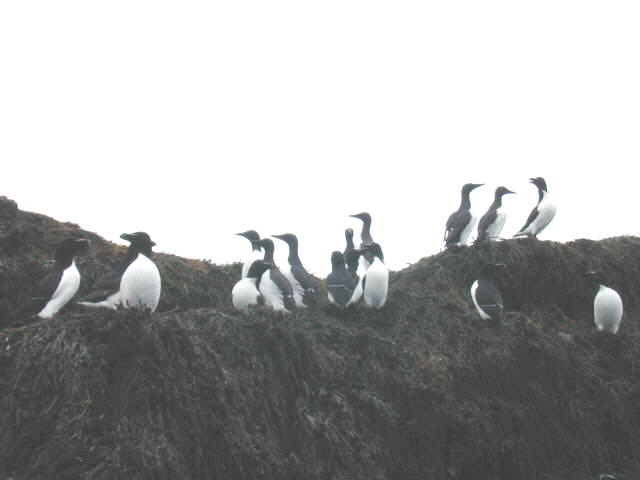
Atlantic Puffin, Common Murre, Razorbill, Arctic Tern, Bicknell's Thrush, Saltmarsh Sharp-tailed Sparrow, WiLSon's Storm-PetReL, Greater Shearwater, Black Guillemot
Michigan 8/13/2000 Gladwin
MI trip saw
lots of casino gambling, boats, waterplay, dining and a bit of
birding. Porcupines andRUFFED GROUSEwere the highlights. A
Cuckoo flew across SR 127 at Territorial Road as we crossed into
Michigan from Ohio. A Black-and-White Warbler flew out of a very
beautiful copse at a rest area near Tawas City. Also very interesting
was a Hermit Thrush that actually attacked my dog and me. We had
evidently stumbled upon a nest. I took video of the unusual event but
haven't looked at it yet. A Raven was also an unexpected pleasure.
8/26/2000
Recent trips to
Paulding area birding spots have resulted in
nearly identical bird counts as that expressed for 8/19, so I was
very excited about an Internet report that a swallow-tailed kite had
been at EmpireMI, near Traverse City for about 2 weeks. A
day trip there found the kite had evidently departed Thursday, but
where he had been were fields full ofVesper Sparrows
Enroute home I stopped at the Muskegon MI
water treatment lagoons, as advised on the internet,
and found a scary but wonderful place with such great birds
as: Stilt Sandpipers, Baird's Sandpipers, Rednecked Phalarope, Eared Grebes Great day that lasted from 7am until
midnight, 750 miles. It was a fine break from the regular locals.
9/17/2000
Went to
Lake Erie
Metropark near
Detroit today for Hawkfest. Interesting
classes and displays kept me busy all day, arriving home about
7:30pm-- without
seeing a single wild hawk!!!! Saw many captive hawks & owls,
though, as well as hundreds of Mallards, hundreds of Great Egrets,
hundreds of Ring-Billed and Herring Gulls, hundreds of Coots, a few
Great Blue Herons, a few Black Ducks, a few CASPIAN TERNS, a few
Lesser Yellowlegs-- it was nice for a change. So different and only
two hours away. Yesterday they had over 50,000 Broad-Winged Hawks
alone; today's huge south wind guaranteed no migration.
10/9/2000
Columbus Day
means the day off from work, spent at Lake Erie Metropark near Detroit.
This is my
second time there, and so different from the first: 2,405 Turkey
Vultures, 670 Sharp-Shinned Hawks, 57 Red-Tailed Hawks, 48 American
Kestrels, 41 Cooper's Hawks, 9 BROAD-WINGED HAWKS, 7 RED-SHOULDERED
HAWKS, 6 Bald Eagles, 4 GOLDEN EAGLES, 3 Northern Harriers, 1 Dark Morph
Rough-Legged Hawk. 10/29/2000 Went to Lake Erie Metropark near Detroit MI
again to
Hawkwatch: 1,139 RedTailed Hawks, 250 Red-Shouldered Hawks, 243 Turkey Vultures, 15
Sharp-Shinned Hawks, 12 Golden Eagles, 10 Cooper's Hawk, 10 Rough-Legged Hawks, 4
Local Bald Eagles, and an amazing 6 NORTHERN
GOSHAWKS! 11/26/2000 Went to Ann Arbor, MI
to see the
reported Ross's Goose The ride there was uneventful until about 5 miles
away from the site, when HEAVY FOG rolled in. I almost turned around
and gave up before even starting, but there it was in binocular- as
opposed to scope-range, in a harvested cornfield on Platt Road
between Bemis and Willis Rds amidst hundreds of Canada Geese,
Mallards and Ring-Billed Gulls. Although it looked like a stubby duck
on the ground, in flight it was amazing and looked huge, so white
against a dark sky! 1/4/2001 Rushed to Grand Rapids
OH at 8 am to see the
HARLEQUIN DUCKposted on Ohiobirds@envirolink yesterday,
and was not disappointed. Since she was a hen, though, I decided to
travel on to Grand Rapids MI, where I saw the drake Harlequin
that had been reported since 12/24 on the Michigan List. Here are
some pictures I hurriedly took off my video camera. I'll replace them
later with better pictures (if it turns out there are better pictures
<grin>). Great time. So many similarities between the two: both
in a town called Grand Rapids, both associating with Mallards (which
also have those 2 white stripes on the back), both between a regular
bridge and a rail bridge, both (most importantly) could be seen from
the parking spot!7/1/2001 A trip to BattleCreek
MI
Binder Park Zoo resulted in seeing a Philadelphia Vireo
the closest I've ever seen one, as it tried to get into the flight
with the finches. Also a pair of Scarlet Tanagers (male and female)
flew over near the Bald Eagle exhibit, as a Bobolink perched
nearby.9/1/2001
Joined the
Stockbridge Audubon Society of Fort Wayne IN for a trip to
Point Mouillee,
near Detroit
MI. The 73 species seen included 20
Shorebirds (BlackBellied Plover, American Golden Plover, Semipalmated
Plover, Killdeer, Great & Lesser Yellowlegs,
Solitary/Spotted/Semipalmated/Least/Baird's/Stilt Sandpipers,
Sanderling, ShortBilled Dowitcher, WILLET, MARBLED GODWIT,RUDDY TURNSTONE).
Also nice were
CASPIAN TERNS,
BLACK TERNS, and Forster's Terns, BROAD-WINGED HAWK, a juvenile
COMMON MOORHEN, all the swallows, Mute Swan, Wood Ducks,
American Wigeon, , BlueWinged and GreenWinged Teal, Northern Pintail,
and COMMON
GOLDENEYE, and
Coot. Best Birds were definitely:BUFF BREASTED SANDPIPERS, and WILSON's PHALAROPES 11/17-18/2001 A non-birding trip to Whitefish Point,
MI
(anyone out
there with experience taking trips with non-birders without allowing
the birding to dominate too much, email me!) resulted in some
fantastic sightings, includingWHITE-WINGED SCOTER THE PINE GROSBEAKS
were amazingly
tame, coming in to the feeders as close as pigeons in a park,
sometimes 25 at once. The COMMON RAVENS, Red and WhiteWinged
Crossbills, and
the hundreds of COMMON REDPOLLS were enough to make this trip a great
one. But aHOARY
REDPOLL was just too much to even ask
for! Although earlier reports indicated hundreds, I was also very
happy to see the singleEVENING
GROSBEAK both pointed out to me by Ken
Mettie, the finder of the ancient murrelet as we sat on a bench
chatting in normal tones as Red Squirrels and these birds ate as free
of fear as in any park. A BOHEMIAN WAXWING flew in as we parted, but later about 5
miles south of Paradise I saw hundreds of Bohemian Waxwings. Tom
Kemp, who I also had the opportunity to meet, wrote in
mich-listers@envirolink ListServe: "...BOHEMIAN WAXWING
- several at Whitefish Point on Nov. 17 and a flock of about 375
roughly two miles south of the Tahquamenon R. mouth on Nov. 18, the
largest flock I have ever seen in Michigan..." This small snippet was
all he had to write about the Point-- obviously the difference is
that this was my first visit, and just one of many visits for him
<grin>. I had excellent directions (Hulbert's Bog, Skyline
Drive etc) to search for gray jay and boreal chickadee but
unfortunately came up empty-handed. I also flunked out on any grouse,
but I was hesitant about entering the woods with so many hunters
about. Besides, it will be a good excuse to return soon! We also took
on some sightseeing while we were there, so took pix of the sights
from the area, that appear on this
site. Before
you go there, let me warn you that it is mostly photos, taken for
family and friends here at home, and so take a while to load unless
you have a DSL or cable modem...Here are a few of the Pine Grosbeaks
taken with a simple Mavicam digital camera (I haven't looked at the
video yet):
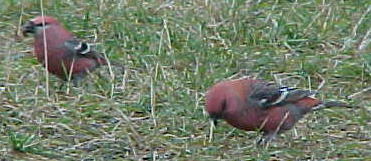

On the 19th, Skye Haas (another birder I had the opportunity to chat with while these unusual birds fluttered in to the feeders) posted a more recent report on mich-listers@envirolink from this spot: "...today at the WPBO giftshop feeders, there were 3 HOARY REDPOLLS, 65 PINE GROSBEAKS and 1 WHITE-WING CROSSBILL. PINE GROSBEAKS, RED & WHITE-WING CROSSBILLS and BOHEMIAN WAXWINGS can be found in most any location in Chippewa and Luce Countys right now."12/28/2001 Joe H. reports from Swanton Reservoir 100 Mallards, from Delta Reservoir 50 Canada Geese and 20 Mallards, and 15 Pine Siskins from the Window on Wildlife at Oak Opening's Mallard Lake. 12/28/2001I left at 9am for Gladwin MI (forgot to stop at the bank last night) but got there at 12:30-- as soon as I pulled into the parking lot, the people waiting motioned that the bird was there! As is my tradition, I got my eyes and belly full then tried to videotape. Only got a few seconds of souvenier-quality video, taping directly into the sun, but oh well, i just can't believe here so close to home was a SAGE THRASHER12/27/2001 Left work early today to go to CentrevilleMI after Joe's encouraging report yesterday. Excellent views of 30 Mute Swans and a BLACK-THROATED GRAY WARBLERHere are a few pictures I hurriedly snapped from the video I took today. They are miserable pictures compared to the fine video I got from only 10 feet away: Of course, I only spent a few minutes trying to snap them, since I am very tired and planning to get up early to see the Sage Thrasher at Gladwin <grin>:
5/1/02 Arrived in Parchment MI (practically in north Kalamazoo,341 Parchmont Street, the home of Carol Birch.) only to find the neighbors were putting in a new entrance. Maybe 10 feet behind me an air compressor blew continually and power saws zoomed intermittently. Nevertheless after only a 25-minute wait, into the suet feeder flew a
who was there for about a total of three seconds <grin>. The videocamera was the only choice with so little time-- not even enough time to focus my 35mm camera. Above are stills taken from the video. The video actually looks good on TV, although it makes for lousy still pictures. Enroute home we stopped at the Battlecreek Mall, and as I waited out in the parking lot two swans flew over, white and huge and beautiful against the steel gray stormy sky. 6/22/02 Bruce and I left for Lawrence MI (BerrienCo) early in the morning, but we had a lot on the agenda and didn't arrive until 6pm. All I could find were BlueWinged Warblers. We went into town at St Joseph and came back at 8:30pm-- there he was! Stayed only a precious few minutes so as not to disturb the nesting pair, took a few seconds of video, and left. Amazing! Astounding! A
7/29/2 Joel S. saw a family of five SANDHILL CRANES at the corner of Ohio/Michigan/Indiana, just barely into Michigan. 8/9/2 Took half-day off work to go to Kalamazoo Michigan to see a Turkey Vulture, 2 BroadWinged Hawks, 2 MISSISSIPPI KITES and a
"Here are all the accepted SWALLOW-TAILED KITE records known from Michigan: 1. 15 Sep 1880, Washtenaw Co, 2. 19 Jun 1882, (2) Monroe, co, 3. c1878-81, "Detriot area" 4. 1897, KALAMAZOO CO. 5. 4 October 1924, Washtenaw Co. 6. 8 August 1992, Barry Co. 7. 22-24 August 2000, Leelenau and Benzie Counties (bird seen in both co's) 8. 6-? August 2002, Kalamazoo Co. (Sources include, "Birds of Michigan" (McPeek and Adams, 1994) and various issues of "Michigan Birds and Natural History". -- Jon Wuepper on Mich-Listers@Envrolink, 8/9/0210/16/2

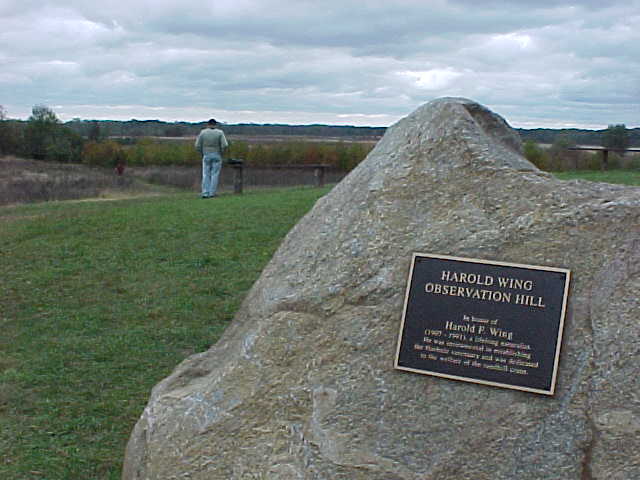
Combined Sweetest Day with a trip to Jackson Michigan's Phyllis Haehnle Sanctuary to see the SANDHILL CRANES . Also there were lots of Harriers, at least one adult male, one adult female and two juveniles. A friendly trio there from Ann Arbor told me they are known to nest there. Then drove on to Marshall MI Baker Sanctuary to see even more SANDHILL CRANES. Don't try to see them on the ground on any day but Sundays 4 to 7 at the Kiwanis Boy Scout Camp entrance. It was fun to see hundreds fly over enroute to their stopover here, but the Baker Sanctuary entrance trail is futile. With no posted notice or sign, 5 cars of people besides me walked the long trail in hopes of a glimpse of the cranes on the ground. The food at Turkeyville near there ended a very nice day:
6/15/3Gladwin A
few days off doing mostly family things, but sneaked out very early
Sunday morning to see nesting Scarlet Tanagers, Hermit Thrushes,
Ovenbirds, Wild Turkeys, YellowBellied Sapsuckers, etc but best was a
GoldenWinged
Warbler close
enough to get pictures:
10/18/3
JacksonCounty MI Haenle Sanctuary
Hundreds of SANDHILL CRANES were of course the
highlights, with a Tundra Swan, a Hairy Woodpecker reaming out a
bluebird box's entrance, a few RingBilled Gulls, flocks of Robins,
Cedar Waxwings, RedWinged Blackbirds, Mallards, etc keeping the Black
Swamp Audubon Society entertained. 12/14/2003 Wayne County
Livonia
(Detroit suburb) I had been scheming to get off work for a
trip to southern Indiana way down on the Ohio River to see this bird,
but then a message on the boards: In a residential section in the
back yard of Jim and Val Nelson at 31668 Bennett St, I had the
tremendous opportunity to view a GREEN-TAiLED TOWHEE with Juncos and a late CHIPPING SPARROW.
Saw lots of Redtailed Hawks, but missed the white RedTail reported at
the I-275 rest area near I-75. 3/6/4 Livingston County,
Michigan Here
to see the reported Spotted Towhee, so I watched the feeders for two
hours seeing only Chickadees (a lot! but hard to count: eight at
once), Titmice (max of 4 at once), 1 Downy, 1 Hairy, 1 RedBellied
Woodpecker, 1 Goldfinch, a Red Jimmy furious with a large Grey
Squirrel on the deck, a few Juncos and lots of Tree Sparrows, 1 House
Sparrow. The darned Towhee sang all around the arc of dense junipers
and thickets surrounding the backyard, once from only ten feet away,
but I never did see him. As I was leaving, he sang from the thickets
in the front yard before the Lowry's drive! 8/8/4 Washtenaw County
MI Addison Two Sandhill Cranes flew
over the car as we were enroute home.
7/12/05 After very dry weather Bruce Heater and I left Sherwood in a thunderstorm with intrepidation, enroute to Point Mouillee in Monroe CountyMI. Our fears were unfounded as the sky cleared for beautiful driving and viewing at Cell 2. Great birds like Marsh Wrens, Soras, tons of ShortBilled Dowitchers, Least/Semipalmated Sandpipers, Killdeer, Greater and Lesser Yellowlegs, a few Stilt Sandpipers, Semipalmated Plover, FIVE COMMON MOORHENS, KING RAILS, and best of all
Our company was great, joining a couple from Novi MI and also Neil Gilbert (ABA/Leica Young Birder of the Year in the 10-to-13-year-old category, from Beverly Hills MI) and his mother. Excellent light, but I forgot the camera. Also excellent timing-- we left just in time as the storms returned practically forcing us off I-75 near Monroe. 8/19/05 When I heard that only 125 miles away in Livingston County MI 10 miles north of Ann Arbor, near Hamburg is a rarity so rare that it is rare in Southeast Arizona in the summer only, very rare in New Mexico and West Texas, I couldn't help but immediately take off after work-- but lo! the car chose today to need a new battery. A rushed new battery (thanks Tuffy!) and by 7:20pm I was there, getting wonderful amazing unbelieveable views until 8:20pm of a

"Welcome to White-Eared Humminbird Way" in chalk on the driveway
Missouri 8/1/2000 In St Louis
MO I picked
up the Eurasian Tree Sparrow 7/8/2002 Arrived home from
Kansas
City
eagerly
scouring Ohiobirds@Envirolink for exciting birds that may have
arrived during my absence, but nothing reported. My family outing
left very little time for birding, and I'm not very conscious of
birding possibilities there in Kansas City. Nevertheless, Saturday
morning I crept out early before the rest of the family awoke and
sneaked around Kansas City in search of perhaps a scissor-tailed
flycatcher that may have wandered too far north. No such luck, but I
did find a YellowBilled Cuckoo near Hoover, two Wild Turkeys
near Platte City, and at Wyandotte County Park a LITTLE BLUE HERON
and a singing
PARULA that came quite close to my Lumina blind.
Cliff Swallows were nesting under the freeway at Congress Blvd just
north of the airport. It was sad to watch English Sparrows robbing
the nests as the anguished parents fluttered nearby in an exercise in
futility. BOBWHITES called from the fields, bringing back
memories of childhood at home in Defiance County Ohio, a sound I
haven't heard in quite some time. Dickcissels were on Farley Hampton
near 435, loud and easily viewed. Spent fireworks casings were all
over this particular road. I couldn't help but wonder what the
Dickcissels' reaction had been! The best find had been the day
before, however, at a visit to the Metro North Mall. As we approached the Pizza
entrance two birds hopped 20 feet in the air above the mall roof, as
if to say "Don't miss us! Here we are! Look up!" Actually they were
attacking a Crow, but how wonderful to see my firstWESTERN KINGBIRDS
They were also all over north of the airport, including some parents
feeding their adult-sized young. Mockingbirds were everywhere; one at
the Metro North Mall fascinated me as he faced down a huge Crow on a
light pole in the parking lot.
Ontario 9/14/2 It was tough turning down the Fort Wayne Stockbridge Audubon Society's kind offer of a tour of Salamonie Reservoir, but I opted to go to the Holiday Beach Hawkfest and Point Pelee near Leamington and Windsor Ontario with the local Northwest Ohio chapter of the Black Swamp Audubon Society.
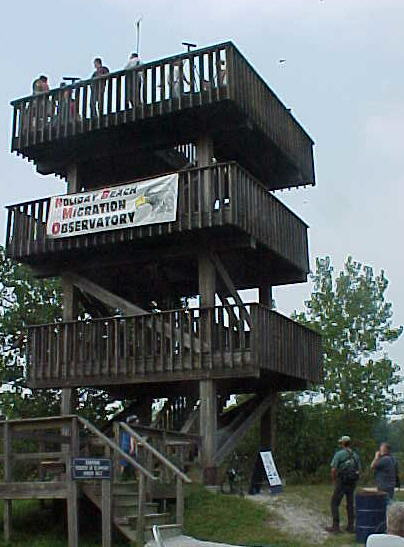
Jon Diller, Dean Flightner and I learned, however, that the stagnant hot weather resulted in stagnant static migration, with extremely few migrants being seen. The lone Osprey, however, stayed in sight the entire time, entertaining us with stoops and dives while it hunted nearby, a lone Peregrine, a lone Harrier, a pair of Bald Eagles, a lone Cooper's Hawk, and a few Kestrels and SharpShinned Hawks were the only migrant raptors, when thousands of broadwings were expected. No warblers were spotted at Point Pelee, but the BlackBacked Gulls at the southernmost Canada landmass were a nice surprise. There were also plenty of other birds uncommon in our area of Ohio right now, including many Mute Swans, many ducks (including Canvasback, Wigeon, Gadwall, Redhead, Scaup), Caspian Terns appearing and disappearing, and the resident Bald Eagles. The programs were of course very entertaining and informative, with the educational raptors on display being very well-received as always. This year there was a Golden Eagle:

the Great Horned Owl:
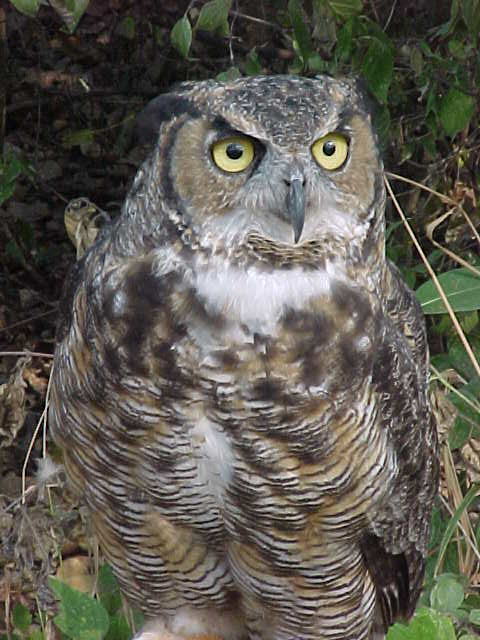
and a Peregrine from Scotland:
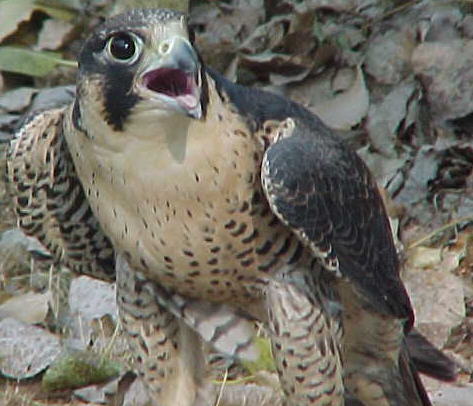
Birdbanding was also slow, but while we were there a Hummingbird and a juvenile female SharpShinned Hawk were netted and banded, with an innovative program to adopt the banded bird:
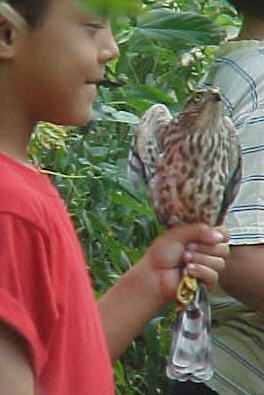
11/3/2 The morning was beautiful from the start, and what better way to start the morning than an adult BALD EAGLE against an pure cloudless azure sky in a yellow tree with fall colors all around? Independence Dam was just that, plus hundreds of RIngBilled Gulls congregated at the dam itself, with almost 100 BONAPARTE'S GULLS. This was enough, but only a little ways away (in Blenheim, Ontario, Canada) I found a wonderfulTROPICAL KINGBIRD
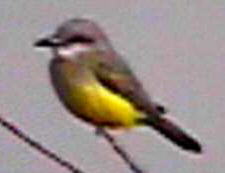
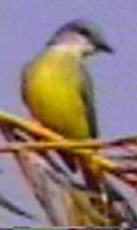
hurried Snappy takes from 8mm video
This bird to my knowledge has never been seen in Ohio (a fall vagrant along the California coast from Mexico, from what I understand), but what a show today! Excellent views as it flew overhead and landed in a nearby Weeping Willow. A SHARP-SHINNED HAWK flew in with this amazing Kingbird the obvious target. She chased the rarity in a circle over our heads (quite a crowd of birders were there) but threw the contest when the Kingbird circled back toward us, landing on the TV antenna of a nearby house. One of those assembled said she had seen the bird hassled by Kestrels yesterday. My rapt attention barely noticed the sound of the TUNDRA SWANS in nearby Rondeau Bay. Another 50 miles down the road (238 miles from home in Sherwood) at Fingal Ontario Canada was aSCISSOR-TAILED FLYCATCHER
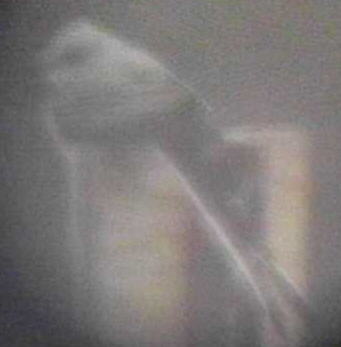
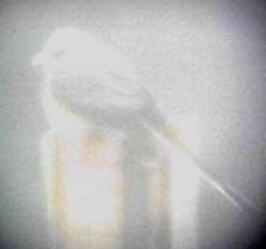
hurried Snappy takes from 8mm video
The parking lot at this wildlife area was full of cars, and with good reason. At one point, this gorgeous avian delight flew from a distant red sumac straight over our heads to a signpost on the other side of us. I was too enthralled watching through my binoculars to remember to get pictures or video of this overhead flight! Enroute home at the Tecumseh exit along the 401, a SANDHILL CRANE flew alongside the car for a ways-- perfect ending, too. Educational too-- did you know the McDonald's outside of Fingal served vegetarian burger with poutain?
9/20/3 HolidayBeach/PointPelee Canada Nine of us from
the Black Swamp Audubon Society made the trip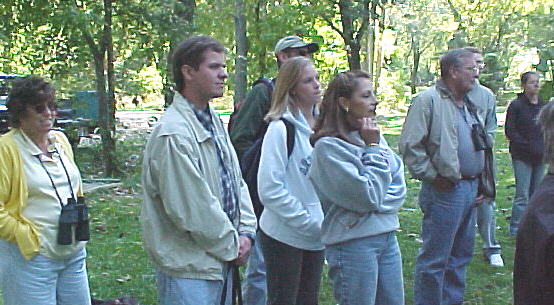 and had a great time, although
Hurricane Isabel did not bring us the gifts for which we had hoped.
and had a great time, although
Hurricane Isabel did not bring us the gifts for which we had hoped.
Our
first great sight was the release of this banded PEREGRINE FALCON
(female dark juvenile): 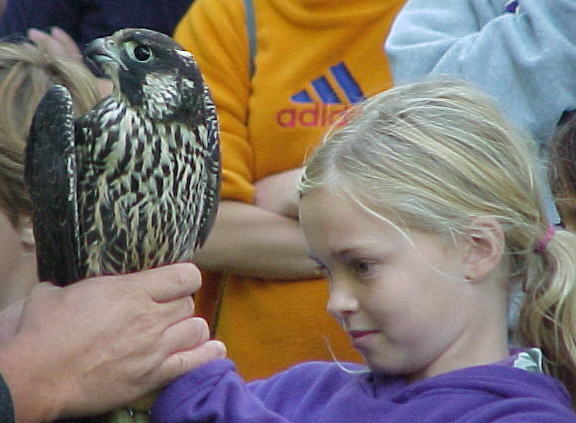
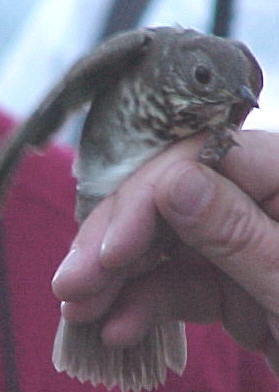 followed closely by our second
great sighting, a newly-banded GREY-CHEEKED THRUSH:
followed closely by our second
great sighting, a newly-banded GREY-CHEEKED THRUSH: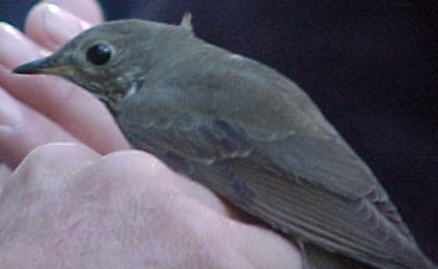 and then this magnificent juvenal
RED-SHOULDERED HAWK:
and then this magnificent juvenal
RED-SHOULDERED HAWK: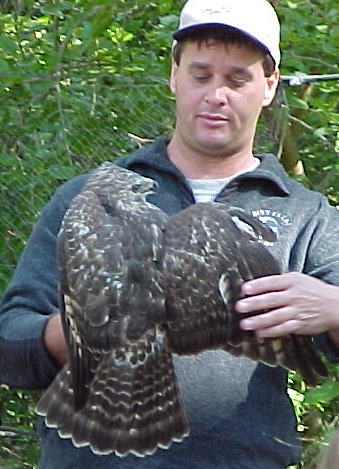
 Our own fearless leader John Diller
released a second-year Sharp-Shinned Hawk of great beauty:
Our own fearless leader John Diller
released a second-year Sharp-Shinned Hawk of great beauty:
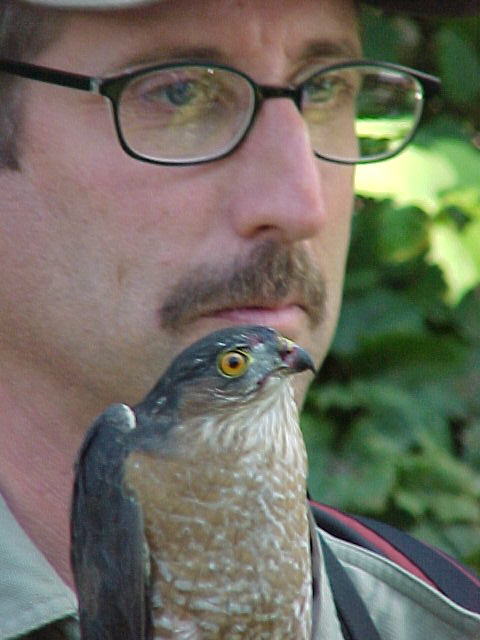
All the other Sharp-Shinned Hawks banded and released while we were there were hatch-year birds:
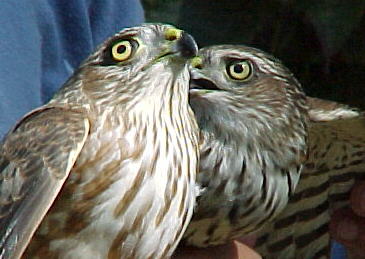

The newly-banded passerines were like new discoveries, seeming so tiny and delicate in the hand:
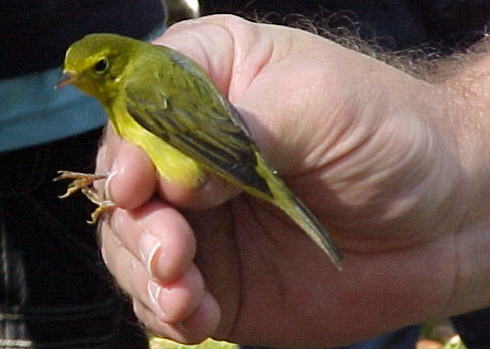 Wilson's Warbler
Wilson's Warbler
Black-Throated Blue Warbler 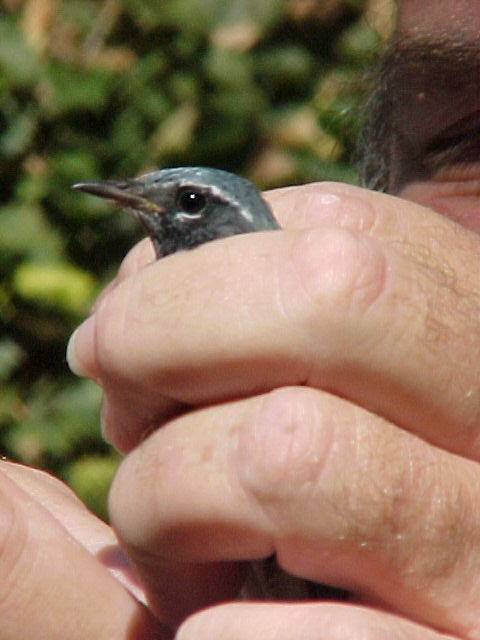
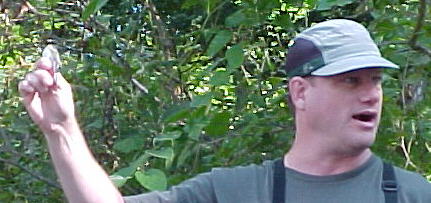 Blackpoll
BlackpollSwainson's Thrush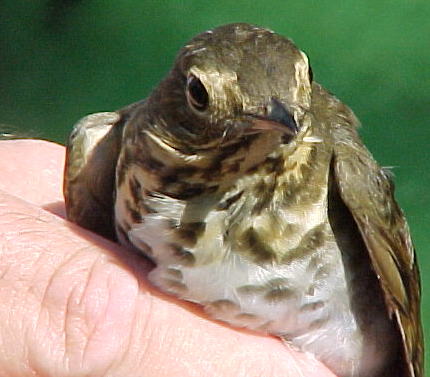
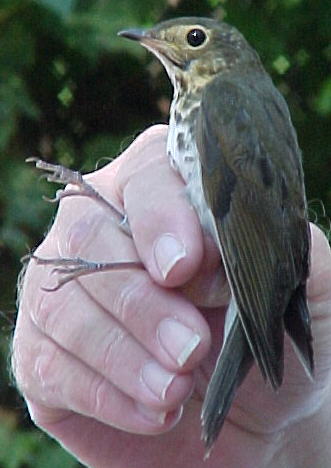
Other great birds there included the loan of a tethered Harris' Hawk by a local falconer:
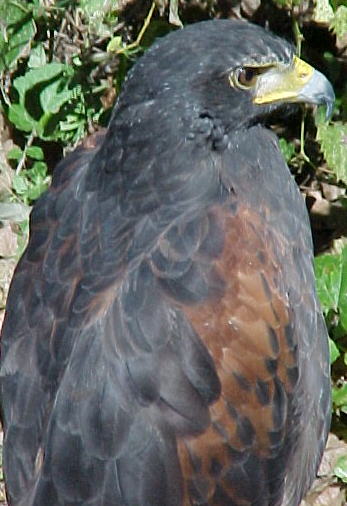
When migrating hawks were slow, we admired the Black-Crowned Night Herons, Mute Swans, Common Moorhens, PiedBilled Grebes, Caspian Terns, etc easily viewed from the tower. Although local birds were few by the Hawk Watchers and Banders' standards (over 9000 Blue Jays, 134 SharpShinned Hawks, 71 Broad-Winged Hawks, 52 American Kestrels, 8 Harriers, 3 Ospreys, 2 RedTailed Hawks, the huge female Peregrine above, and the record-early RedShouldered Hawk) they were indeed startling for us (much like this mesmerized newly-banded SharpShin on a little girl's hand) and a great time was had by all:
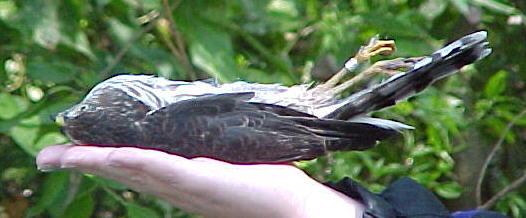
1/1/2004 Lessee, should I take the great day and scout for the CBC or head to London Ontario Canada? Arriving about 3pm, and following the internet instructions "... Do not park on this quiet street. Park on the north(right) side of Village Green. Walk up Lynngate Place to number 120. Go to the RIGHT side of the house, and walk up the driveway of the next door neighbour's house, #116, along the..." I immediately ran over a roofing nail and the tire quickly went flat. Rushed back to see if the bird was present (it wasn't; two ladies-- Jeannette and Sharon from near Flint MI-- had been waiting already an hour), rushed back and changed the tire, rushed back and about 4:20pm a female immature Cooper's Hawk showed up. It scared away all the birds that had entertained us up to that point, including a RedBreasted Nuthatch, but fortunately stayed only five minutes or so. It was getting darker and darker when Hugh Casbourn (whose post I had originally read) arrived, told us that apparently many were reporting various adult/juvenile, male/female, Cooper's/Sharpshinned Hawks at this site. He told us the bird had missed several morning feedings but never an evening feeding, and not to give up until the last Cardinal had left. Hugh left, but his visit encouraged us to wait, and at 4:53 from the spruces behind the neighbors in flew the coveted
What in the world?!! This was no rock dove eating spilled grain on the ground! This huge bird ate 297 sunflower seeds (Sharon counted!) from a platform feeder some 6-8' in the air! And in under 10 minutes he was gone, back to the spruces in the neighbor's yard. A California bird in Ontario. Whoulda thunk it? 12/30/3 it had been reported that "the pigeon was perched in one of the trees around the feeders when a Cooper's Hawk came in and struck it about 9:25. Feathers flew and so did the pigeon, back to its roosting trees." When I read the sign posted at the site I found that 12/7/3 this rare bird had been hit by a Cooper's Hawk and wounded so badly that it had been caught and kept in a cage for two weeks to recover! Even with a 55-minute wait to get back into the US at Sarnia, it was simply fantastic that such a bird should survive all the impossibilities and certainly well worth the trip. The wait probably would have been even longer at Windsor, where (when we drove into Canada) traffic to get back into the US had been backed up across the bridge!
However, a website by a Menlo Park CA birder http://www.birdhike.com/pigeons.htm says, "Band-tailed Pigeons, the Flying Pigs-- During the summer, our tube feeder becomes primarily a feeder for Band-Tailed Pigeons. These fellows seem like they are twice the size of a city pigeon (Rock Dove) or Mourning Dove, and they have voracious appetites. They eat the sunflower seeds whole, which is a benefit for us, since we don't have to clean up so many hulls. They have terrible feeder manners, as newcomers routinely land on the backs of those already on the feeder tray. Friends claim to have seen them stacked 3 deep at a large feeder. They also growl at each other. I can't think of a better term to describe the noises they make."
I did have my camera with me, but it was nearly dark at 5pm, and flash was out of the question. I definitely could not hold the camera still long enough for the extended length the aperture was open, so they were pretty darn blurry. Or any other excuse you can think of <grin>. Nevertheless, I did snap off a few documentary photos in the very few minutes we had:
Area Birding Recent Reports, or just Birding in general
Old Reports from: Defiance County (Oxbow Lake, Independence Dam, Sherwood OH, the Rest of Defiance County), Paulding County, Williams County, Fulton County, Western Lake Erie spots, other Ohio counties, and occasional out-of-state wild bird sightings by this Northwest Ohio resident.
My Pets My Cat, My Dog, My Pet Finches
My Garden in April, in May, in June, in July (these are very photo intensive, consisting almost entirely of pictures. DSL or better advised)